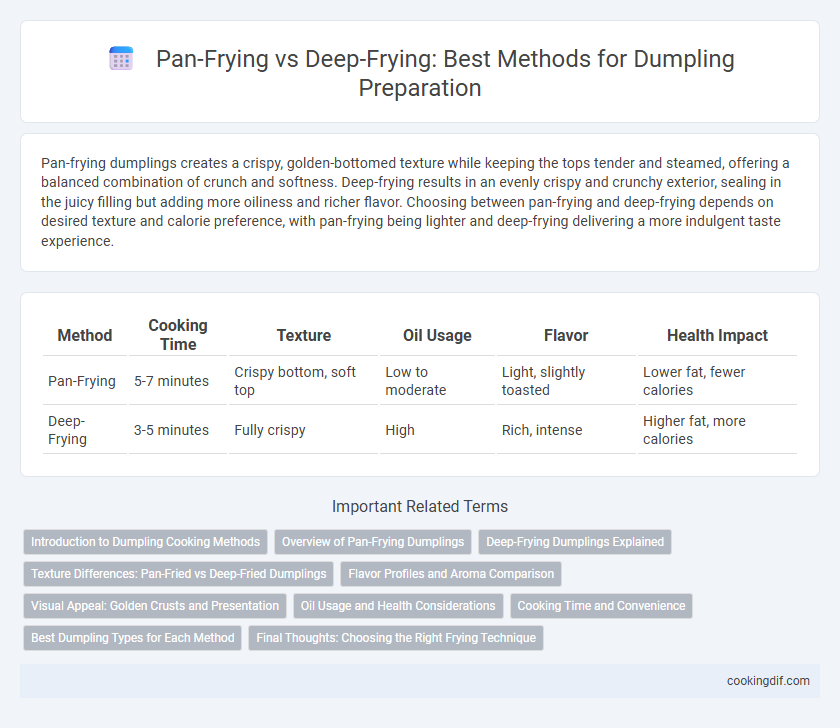Pan-frying dumplings creates a crispy, golden-bottomed texture while keeping the tops tender and steamed, offering a balanced combination of crunch and softness. Deep-frying results in an evenly crispy and crunchy exterior, sealing in the juicy filling but adding more oiliness and richer flavor. Choosing between pan-frying and deep-frying depends on desired texture and calorie preference, with pan-frying being lighter and deep-frying delivering a more indulgent taste experience.
Table of Comparison
| Method | Cooking Time | Texture | Oil Usage | Flavor | Health Impact |
|---|---|---|---|---|---|
| Pan-Frying | 5-7 minutes | Crispy bottom, soft top | Low to moderate | Light, slightly toasted | Lower fat, fewer calories |
| Deep-Frying | 3-5 minutes | Fully crispy | High | Rich, intense | Higher fat, more calories |
Introduction to Dumpling Cooking Methods
Pan-frying dumplings involves cooking them in a small amount of oil over medium heat, resulting in a crispy bottom and tender steamed top, preserving the dumpling's flavor balance. Deep-frying submerges dumplings fully in hot oil, producing a uniformly golden and crunchy texture that intensifies the filling's taste. Both methods highlight different textures and intensities, catering to varied preferences in dumpling preparation.
Overview of Pan-Frying Dumplings
Pan-frying dumplings involves cooking them in a small amount of oil over medium heat, creating a crispy, golden-brown bottom while keeping the tops tender and steamed. This method preserves the dumpling's delicate texture and enhances flavor through caramelization, resulting in a balanced contrast of crispiness and softness. Popular in Asian cuisine, pan-frying is a versatile technique ideal for achieving dumplings with a satisfying crunch and juicy interior without excessive oil absorption.
Deep-Frying Dumplings Explained
Deep-frying dumplings creates a crispy, golden-brown exterior while sealing in the juicy filling, offering a satisfying contrast in texture. This method requires submerging the dumplings in hot oil at temperatures between 350degF to 375degF for 3 to 5 minutes to ensure even cooking and a crunchy finish. Unlike pan-frying, deep-frying produces a consistently crispy shell, making it ideal for dumplings with hearty or moist fillings.
Texture Differences: Pan-Fried vs Deep-Fried Dumplings
Pan-fried dumplings develop a crispy, golden-brown bottom with a tender, steamed top, creating a contrast of textures that highlights the juicy filling inside. Deep-fried dumplings achieve uniform crispiness across the entire surface, resulting in a crunchy exterior that encases a hot, dense interior. The choice between pan-frying and deep-frying significantly impacts the overall mouthfeel and texture experience of the dumpling.
Flavor Profiles and Aroma Comparison
Pan-frying dumplings creates a crispy, golden-brown texture with a slightly smoky aroma that enhances the savory filling's natural flavors. Deep-frying produces a uniformly crunchy exterior with a rich, indulgent oil-infused taste, intensifying the dumpling's overall flavor complexity. The aroma from pan-frying is lighter and more nuanced, while deep-frying delivers a robust, enticing scent that highlights the dumpling's fried essence.
Visual Appeal: Golden Crusts and Presentation
Pan-frying dumplings creates a visually appealing golden crust with a crisp texture that highlights the contrast between the soft, steamed upper layer and the crunchy bottom, enhancing presentation on any plate. Deep-frying yields an evenly golden and uniformly crispy exterior, providing a consistent and bold look that stands out in appetizers or snack platters. Both methods offer distinct visual qualities: pan-frying emphasizes a dual-texture appearance, while deep-frying delivers a fully crisp and vibrant golden finish.
Oil Usage and Health Considerations
Pan-frying dumplings uses less oil than deep-frying, typically requiring just a tablespoon or two to achieve a crispy bottom while steaming the filling, making it a healthier option with lower fat content. Deep-frying involves submerging dumplings in hot oil, significantly increasing oil absorption and calorie intake, which may raise health concerns due to higher fat and potential trans-fat exposure. Choosing pan-frying not only conserves oil but also reduces the risk of heart disease linked to excessive fried food consumption.
Cooking Time and Convenience
Pan-frying dumplings typically takes around 6-8 minutes, offering a balance of crispy texture and tender interior with minimal oil usage and easy temperature control. Deep-frying, while faster at about 3-5 minutes, requires more oil and careful monitoring to prevent overcooking or grease absorption. Pan-frying is generally more convenient for home cooks seeking a healthier option and less mess, whereas deep-frying suits those prioritizing speed and a uniformly crispy finish.
Best Dumpling Types for Each Method
Pan-frying is ideal for potstickers and gyoza due to their thin wrappers and delicate fillings, which develop a crispy bottom while retaining moist interiors. Deep-frying suits wontons and fried shu mai, as their sturdy wrappers and dense fillings hold up well and achieve a uniformly crunchy texture. Choosing the right frying method enhances the dumpling's texture and flavor profile, matching preparation style with dumpling characteristics.
Final Thoughts: Choosing the Right Frying Technique
Pan-frying dumplings creates a crispy, golden bottom with a tender, steamed top, offering a balanced texture that highlights the filling's flavors. Deep-frying produces uniformly crispy dumplings with a rich, crunchy exterior but can overpower delicate fillings due to the high oil content. Choosing between pan-frying and deep-frying depends on the desired texture and flavor intensity, with pan-frying favored for a lighter, nuanced taste and deep-frying preferred for maximum crispiness.
Pan-frying vs Deep-frying for dumpling preparation Infographic

 cookingdif.com
cookingdif.com